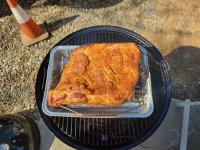Kevin L (NKY)
TVWBB Diamond Member
We are having hit and miss weather so I am working smoking a Pork Should 8#. And I want to serve about noon on Sunday at a fellowship lunch. So Sunday morning perp is limited.
My question is if I smoke it on Friday or Saturday depending on weather calling for more rain, how do I hold it for the lunch? Do I just leave it in the cooler un shredded, or shred mix in sauce and rub bag and reheat in a slower cooker that morning?
Thank you ahead for all or any replies. This is a special day and a special meal.
My question is if I smoke it on Friday or Saturday depending on weather calling for more rain, how do I hold it for the lunch? Do I just leave it in the cooler un shredded, or shred mix in sauce and rub bag and reheat in a slower cooker that morning?
Thank you ahead for all or any replies. This is a special day and a special meal.

